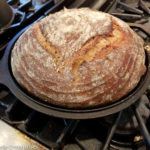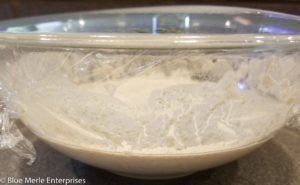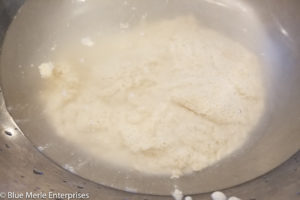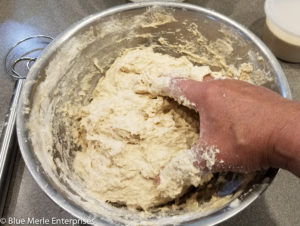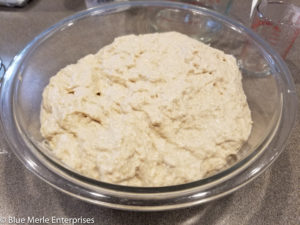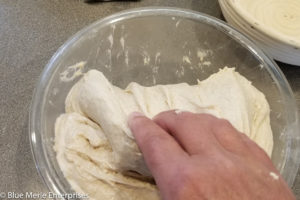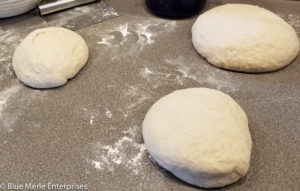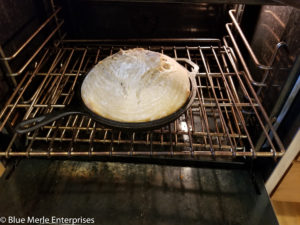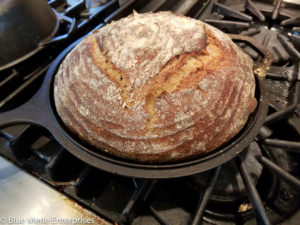Rustic Sourdough Bread
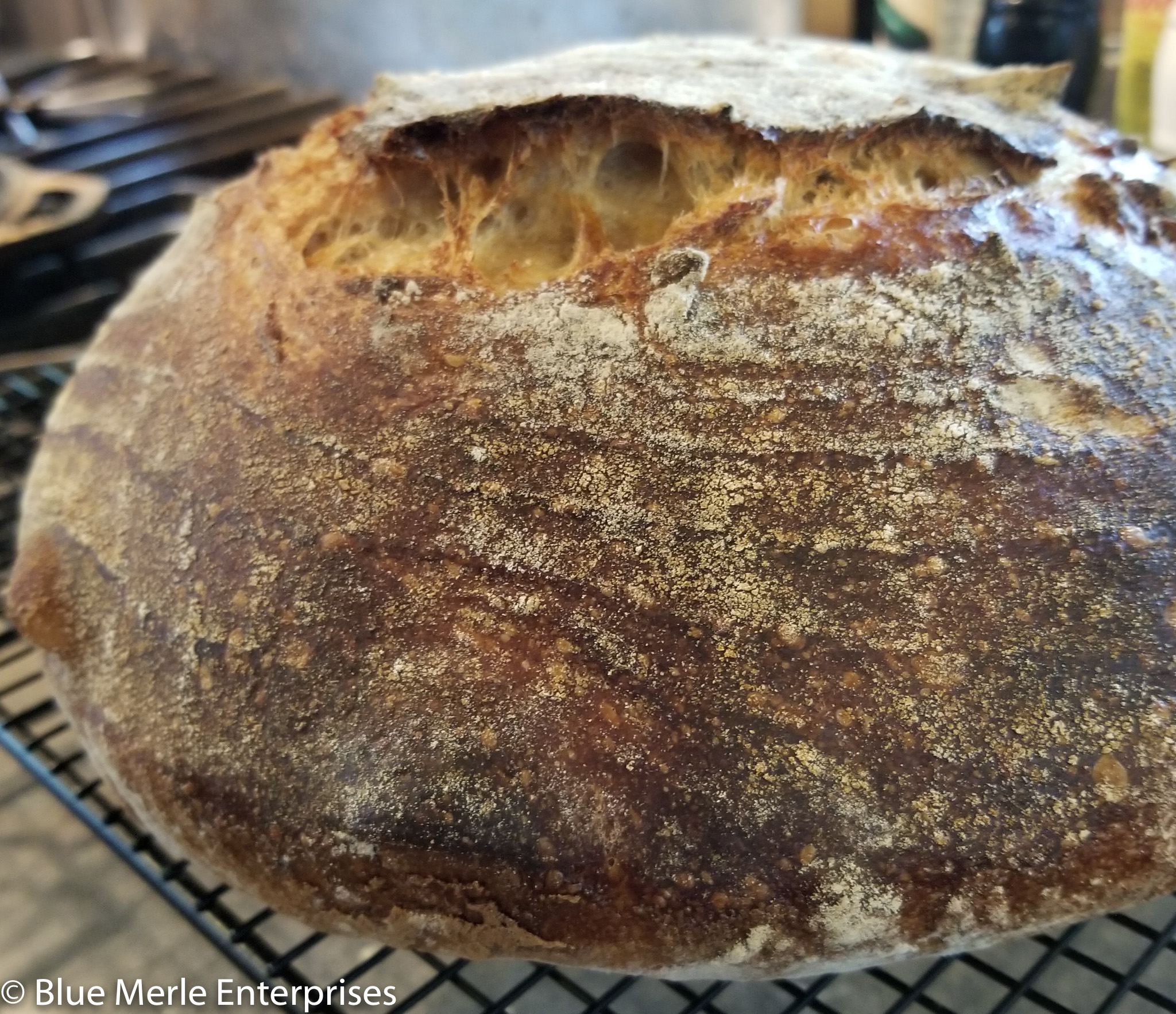
After receiving a 30 year old sourdough starter, I asked a neighbor how to make a decent loaf of rustic sourdough bread. She lent me a copy of “The Tartine Bread” book.
I made a loaf of their “Basic Country Bread” and I was hooked.
I highly recommend “The Tartine Bread” book. The book has clear step-by-step instructions and photographs that can guide you to exceptional bread-making.
I’ve brought this bread to dinner parties where it got rave reviews from my friends. I have even exchanged a loaf for several pounds of moose meat!
This recipe makes two medium sized (9 inch diameter) loaves. The recipe also makes excellent pizza dough (enough for 4 pizzas) and great focaccia.
My recipe uses a higher percentage of whole wheat and has a couple of modifications to deal with the way I handle my starter and such.
Rustic Sourdough Bread
Equipment
- Dutch oven or cast iron combo cooker
Ingredients
Freshly fed sourdough (Leaven)
- 1 cup sourdough starter
- 250 grams water warm, about 80 ºF
- 250 grams flour 50/50 mix of white and whole wheat
Dough
- 700 grams water warm, about 80 ºF
- 200 grams leaven (fed sourdough)
- 750 grams white bread flour
- 250 grams whole wheat flour
- 20 grams salt
- 50 grams water warm, about 80 ºF
Instructions
Feed the sourdough starter
- The night before you want to make the dough, pull out a cup or so of sourdough starter from your fridge.
- Put the sourdough starter in a large glass (or plastic) bowl.
- Add the flour and water and stir it into a smooth batter. Then cover the bowl with plastic wrap and let it sit in a warm place overnight.
- My neighbor will sometimes put the bowl in an oven with the light on to keep it warm during our long, cold Alaska nights.
Dough
- Add 700 grams of warm water to a large mixing bowl.
- Add 200 gram of leaven ( fed sourdough starter) to the bowl. Mix it with the water.Put the remaining starter in a plastic container and store it in the fridge. This will be the starter for future recipes.
- Add 750 grams of white bread flour and 250 grams of whole wheat flour to the bowl of water and leaven. Mix it by hand. Be sure there are no dry bits of flour, but don't knead it.
- Let the dough rest for 30 or 40 minutes. This is the autolyse stage and is important to hydrate the dough, begin enzymatic processes and start the formation of gluten bonds.
- Sprinkle 20 grams of salt over the dough and add 50 grams of warm water.
- Incorporate the salt and the water into the dough by squeezing the dough through your fingers. It may take a fair amount of squeezing, but eventually all of the water will be incorporated and the salt will have dissolved.
- Transfer the dough to a medium sized plastic or glass container. This will begin the bulk rise stage.
- After 30 minutes, turn the dough. A turn is done by wetting you hand with water (to prevent sticking), then reach into the dough along one side grab the bottom and pull it over the top and repeating 3 or four times around the bowl. For a good explanation of this, see the "Tartine Bread" book referred to above.
- Over the course of the next 3 or 4 hours, repeat the turn every 30 minutes. You should be able to feel the dough getting more aerated, softer, and cohesive.
- Sprinkle some flour on the top of the dough and turn it out onto your counter. Use a bench knife to cut it into two equal sized pieces of dough. Each piece will make one good sized loaf. I often cut one of the pieces into half again, giving me dough for pizza or focaccia. This way I get 1 nice loaf and a couple of pizzas from each recipe.
- After cutting the dough, use floured hands to form them into round shapes. Then let them sit for 30 minutes. This is the bench rest phase.
- During the bench rest, I prepare banneton baskets (proofing baskets) by giving them a light spritz of water and flouring them with rice flour.If I do not have banneton baskets, I line medium sized bowls with kitchen towels and use a 50/50 mix of rice flour and whole wheat flour to flour the towels.
- After the 30 minute bench rest, each round is shaped to be put into the baskets. Lightly flour the top of a round and flip it upside down onto your counter. Then pull the dough at the 6 o'clock position toward you and then fold it into the center of the round. Pull the dough at the 3 o'clock position to your right and fold it into the center of the round. Pull the dough at the 9 o'clock position to your left and fold it into the center of the round.Pull the dough at the 12 o'clock position away from you and then fold it into the center of the round.
- Use a bench knife to help lift the rounds into your prepared baskets. Cover the baskets with a kitchen towel.
- Let the dough rise. At room temperatures, 4 hours works for me. I also like to put the dough in the refrigerator overnight to rise overnight. This seems to give more complex flavors to the bread. It also relieves the stress of trying to get a fresh loaf baked when time gets away from you.
Baking
- This technique requires a combo cooker or a dutch oven with a lid.
- If your dough is in the refrigerator, pull it out.
- Put the two pieces of the combo cooker (or dutch oven and lid) into the oven. Preheat your oven to 500 ºF for about a half hour.
- Now the fun of dealing with HOT heavy cast iron begins.
- Use good oven mitts to pull the bottom of the combo cooker (or dutch oven) out of the hot oven and place it on the stove top.
- Take the basket with risen dough and invert it to turn the dough out and into the HOT pan.
- Use a bread lame or razor blade to score your loaf (watch out for the HOT sides of the pan).
- Use good oven mitts to pull the top of the combo cooker (or dutch oven) out of the hot oven and cover the loaf with it. Then return the cooker setup (or dutch oven) to the HOT oven.
- Drop the oven temperature to 450 ºF and bake for 20 minutes.
- Use good oven mitts to carefully take the top off of the combo cooker (or dutch oven) and cook for an additional 20 minutes.
- The top should be a deep brown, remove it from the oven and transfer it to a wire rack to cool.
A Note About Equipment
Cast Iron Combo Cooker
You can use a cast iron dutch oven instead of a combo cooker.
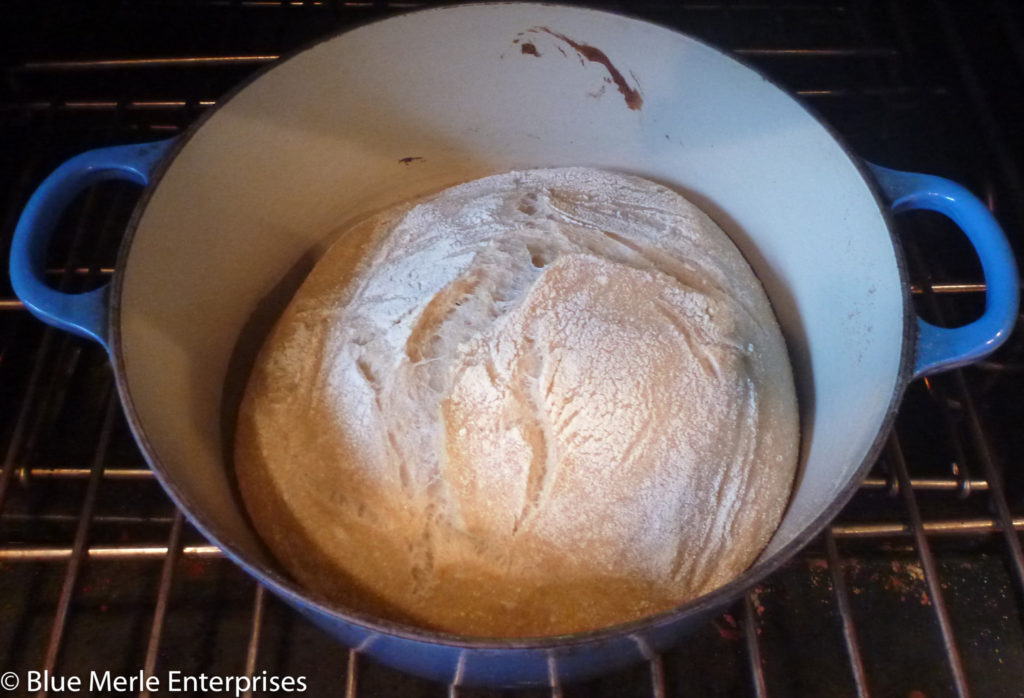
Heat up both the base and the lid in a 500 ºF oven and follow the instructions in the recipe above. Some dutch ovens, like the Le Creuset that I own, have black phenolic knobs. This knob is only rated to 390 ºF so you should replace it with a stainless steel knob.
Another issue with a dutch oven is the high sides make it difficult to turn the dough out into the HOT pan and the potential for burning your arm when scoring the loaf is high.
If you plan on making this kind of bread on a regular basis, I highly recommend buying a cast iron combo-cooker.
Banneton Basket
When I first started making these loaves, I used a bowl lined with a floured kitchen towel for the final rise of this recipe. Flouring the towel with a 50/50 mixture of rice flour and whole wheat flour worked most of the time, but it did sometimes stick to the loaf. Because this recipe involves turning out the dough into 500 ºF pans, even the occasional sticking results in cussing.
I now use a 9-inch diameter banneton (proofing basket). Some of these come with a linen liner, but I don’t use it. I spritz some water into the basket to get it damp, dust it with rice flour, and let it dry before putting the dough in for the final rise.
Using a banneton also gives you a loaf with nice rings around it.
